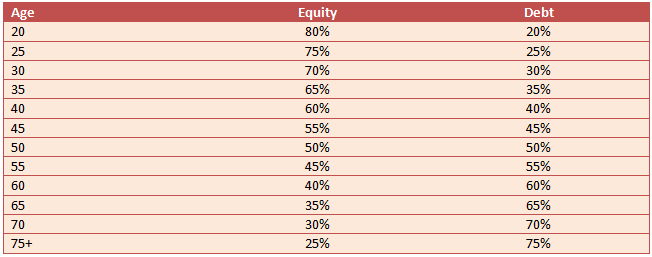Why you should adopt life cycle based investment strategy

Life-cycle fund, as a concept, was first introduced by the US Federal Government through a scheme called Thrift Savings Plan. Now this scheme is managed by private Asset Management Companies (AMCs). Life-cycle funds are quite popular in the US for retirement planning. Life-cycle funds are very useful for long term investment planning, particularly retirement planning, because the investment risk is managed continuously throughout the investment tenure according to the stage of life of the investor.
In the early stages of the investment in life-cycle funds, e.g. first 20 years or so investors get high exposure to equity; then the asset allocation is gradually shifted to debt by selling stocks and buying bonds aligning the risk profile of the fund with the risk capacity of the investor who is approaching retirement. The life-cycle based investment strategy helps investor get optimal returns to meet their investment goals without exposing them to excessive capital market risks. Let us now discuss life-cycle based investment solutions in India.
Life-cycle mutual funds in India
In India a few Asset Management Companies offer few life-cycle mutual fund schemes but this category of funds is not very popular in our country. Life cycle funds are usually structured as fund of funds and as per our tax laws,fund of funds are taxed as non-equity funds or debt funds, even though these life-cycle funds may have a large exposure to equity, in early stages of the investment lifecycle. Long term capital gains in equity funds, till the last financial year, was tax free. From this financial year onwards, long term capital gains of up to Rs 1 Lakh in equity funds will be tax free; long term capital gains in excess of Rs 1 Lakh will be taxed at 10%. Long term capital gains in debt funds, on the other hand, are taxed at 20% after allowing for indexation benefits. The unfavorable tax treatment of life-cycle fund of funds compared to equity funds makes life-cycle funds unattractive for investors and as such, there are not many mutual fund product offerings in this category.
You may like to read how you can optimize your asset allocation with mutual fund
NPS Life-cycle Funds
The National Pension Scheme (NPS) has a life-cycle fund, also known as Auto-Choice option in NPS terminology, where the asset allocation between equity (stocks) and debt (bonds) keeps changing with age. There are three options – aggressive, moderate and conservative in the NPS life-cycle, which investors can select based on their risk appetites. NPS investments enjoy tax savings benefits under Section 80C benefits up to Rs 1.5 Lakh; NPS investors can claim tax deductions of additional Rs 50,000 (over and above 80C limit). For investors who want to maximize tax savings, NPS is a good investment option.
However, the biggest disadvantage of NPS is the tax treatment of the maturity corpus (post retirement). Firstly, 40% of the maturity corpus has to be compulsorily invested in annuities. While investing in annuities can provide post retirement income to investors, the flip-side is that, the investors cannot deploy the maturity corpus in alternative income solutions. Secondly, the annuity income is fully taxable as per the income tax rate of the investor. Thirdly, out of the 60% maturity corpus that can be withdrawn by the investor post retirement, only 40% is tax free – the balance is taxable as per the income tax rate of the investor.
Life Insurance Retirement Plans
Life insurance companies offer retirement plans with life-cycle fund like features through Unit Linked Insurance Plans (ULIPs), though these plans are not strictly life-cycle funds. You can change your asset allocation by switching from equity fund to debt fund or vice versa, depending on your stage of life. Some life insurance companies have a cap on the number of free switches you can do in a policy year and then they charge a certain fee for each switch. Some life insurance companies allow unlimited free switches in a policy year.
Investors should know that, while in life-cycle funds asset allocation is adjusted automatically according to the life-stage and the asset allocation schedule of the fund, in most ULIP retirement plans the investors have to trigger the switches themselves. Further investors should also know that, unlike mutual funds, the entire investment / premium in ULIP is not invested in the funds – a portion of the premium is used for providing life insurance cover to the investor and only the remaining portion is invested. Since the amount getting actually invested is less than the amount that the investor puts, the return on investment for the investor is lower.
Alternative life-cycle based investment strategies for investors?
As discussed in this article, there are not many life-cycle fund choices in India and the ones which are there, are not very tax efficient or cost efficient. However, if investors understand the concept of life-cycle based investment strategy, then they can develop and execute the strategy quite efficiently and effectively using mutual fund schemes.
The underlying concept of life-cycle based investing is essentially asset allocation in relation to changing risk capacities over the investor’s life-cycle. It is important for readers to understand the difference between risk capacity and risk appetite. Risk capacity is the capacity of an investor to absorb losses, without impacting his / her financial goals and financial liquidity. Risk capacity depends on a variety of factors like stage of life, goal tenure, income stability, financial liabilities etc. Risk appetite, on the other hand, is a person’s attitude towards risk or volatility. A person with a high risk capacity, e.g. a young working professional may have low risk appetite, while a person with low risk capacity, e.g. a retiree may have high risk appetite.
We suggest you to read – Asset allocation strategies for different age groups
The basis of life-cycle based investment strategy is the risk capacity in different stages of life. Life-cycle based investment strategies are used for very long term goals, particularly for retirement planning. Over very long investment tenures, investors go through different stages of life and their risk capacities change accordingly. For example, when the investor is young, he / she has high risk capacity – even if they make a loss in their investment, they have sufficiently long time to recoup their losses. Older investors have lower risk appetites because the retirement goal post is approaching.
When forming an investment strategy, investors should understand the relationship between risk and return – the relationship between risk and return is fundamental to asset allocation. Asset allocation is the mix of different asset classes in the investor’s portfolio. In its most basic form, asset allocation is the mix of equity and debt in the investor’s portfolio. Different asset classes have different risk profiles, e.g. equity is risky, but gives higher returns in the long term; debt is safer, but gives lower returns.
Read how you can protect your investments from volatile markets
In life-cycle based investment strategy the asset allocation is tuned to the risk capacities in different stages of life in the investor’s life-cycle. For example, when the investor is young, the asset allocation is skewed towards equity; equity allocation can be as high 80%. As the investor gets older, the asset allocation gradually shifts from debt to equity. By the time the investor retires, debt will form the major portion of the asset allocation. The investor will gradually keep changing the asset allocation as he grows older.
In case you are not familiar with debt mutual funds, do read this piece – demystifying debt mutual funds
Executing life-cycle based investment strategy with equity and debt funds
Investors can easily execute this strategy using mutual funds. In the simplest form, you can start by investing a portion of your funds in a diversified equity fund and an income / debt fund, in proportion of your target asset allocation based on their age / stage of life. Depending on your risk appetite, you can choose a midcap fund or a large cap / balanced fund. You can also invest in multiple equity funds and multiple debt funds if you want to diversify fund risks. However, the asset allocation proportion (equity to debt proportion) should match your target asset allocation based on stage of life. When your target asset allocation changes with age, you should switch a portion of your equity investment to debt. You can do this either by redeeming a portion of your equity funds and investing the redemption proceeds in debt funds. Alternatively, if both the equity fund and debt fund are from the same fund house, you shift your asset allocation through a simple switch transaction. If the stock market falls, reducing the proportion of your asset allocation in equities, you should switch from debt to equity. This strategy can be executed once every year or once every few years (e.g. 5 years), when you are young. However, as you are nearing your retirement, you should execute the asset allocation more frequently, every one or two years.
You must read why asset allocation is much more important than fund selection
Equity funds enjoy tax advantage over life-cycle fund of funds – therefore, from a tax standpoint this strategy is more efficient than life-cycle funds. This strategy is also fairly easy to understand and execute without much effort – if you have a financial advisor, he / she can do most of this work for you. You can execute this strategy both with periodic lump sum investments and Systematic Investment Plan (SIP) – the SIP amounts in equity and debt funds, should be in proportion of your target asset allocation. One question, which many readers will have is, what is the optimal target asset allocation at different stages of life?
Rule of 100
This is a very popular asset allocation thumb rule, which aligns asset allocation to different stages of life. In the Rule of 100, you simply subtract your age from 100, and the result suggests the maximum percentage amount of your portfolio that should be exposed to equities. So for a 25 year old investor, this rule suggests that 75% of his / her portfolio should be invested in equities, and for a 40 year old investor, this rule suggests that 60% of the portfolio should be invested in equities.

Every time, you rebalance your portfolio, you should ensure that the asset allocation is aligned with the stage of life target asset allocation (as shown in the table above). Please note that the Rule of 100 is simply asset allocation guidance – depending on your risk appetites, you can opt for different asset allocation models, but you must take your risk capacity / stage of life in consideration when deciding your asset allocation for life-cycle investment strategies.
How often should your re-balance your portfolio in life-cycle based investing?
As discussed, life-cycle based investment strategy is for long investment tenures, typically retirement planning. To get the best benefits of life-cycle based investment you should start early in your career; earlier the better. Based on our experience, there is no great advantage in rebalancing frequently early in the investment life-cycle. You should take tax treatment of returns in consideration in deciding when to rebalance – if you want to avoid short term capital gains tax in debt funds, then you should not rebalance from debt to equity before three years from the date of investment.
Read why making investments in equity funds should be your priority if you are young!
If you are investing through SIP, then also tax becomes an important consideration - you should ensure that the switch from equity to debt or vice versa does not attract short term capital gains tax. As such, till you are 40 – 45, rebalancing every 5 years or so should be good enough. However, once you are nearing your retirement, you should rebalance more frequently. When you are closer to retirement, risk considerations should be given higher priority to tax considerations.
The long term capital gains tax for equity funds announced by the finance minister in this year’s budget incentivizes investors to book up to Rs 1 Lakh of tax free profit every year for long term investments. Remember, for tax purposes,profits are booked, only when you redeem or switch. If you do not book profits in a financial year, under the new capital gains tax regime, the benefits are lost.
Let us understand this with the help of an example -
Suppose you invest Rs 10 Lakhs in an equity fund this year. Let us assume you make Rs 1.2 Lakhs of profit in the fund in this financial year. If you book the profits this year itself and re-invest in another fund, then Rs 1 Lakh profit will be tax free, only Rs 20,000 will be taxable at 10% - you can also choose to book just Rs 1 Lakh profit. Now, let us suppose, you make a profit of Rs 1.5 Lakhs in the next financial year also. Again if you book the profit, then Rs 1 Lakh will be tax free and only Rs 50,000 will be taxable. So over the next two years, only Rs 70,000 profit will be taxable. Now let us consider the alternative scenario, where you do not book profits this year and wait for 2 years to book profits. In that case your total profit will be Rs 2.7 Lakhs, out of which Rs 1 Lakh will be tax free and Rs 1.7 Lakhs will be taxable – you will be paying a much higher amount in tax compared to the previous scenario.
We have explained the tax consequences of different profit booking scenarios under the new capital gains tax regime, but in our view, in interest of investors, long term capital gains tax changes should not encourage behavior which can harm the long term interest of investors. While profit booking can save taxes to certain extent, it prevents you to benefit from the power of compounding in the long term. As far as life-cycle based investment strategy is concerned, you can take advantage of tax free portion of equity long term capital gains every year, but in our opinion, only to the extent how much is required to shift your current asset allocation to the desired / target asset allocation.
Conclusion
Life-cycle based investment strategy is the ideal strategy for retirement planning. Unfortunately, in India, due to various factors, we do not make the most efficient choices in this investment products category. In this blog post, we discussed how you can design and execute an efficient life-cycle based investment strategy using mutual funds. We also discussed how tax considerations play a role in asset allocation decisions. Investors should discuss life-cycle based investment strategies with their financial advisors and formulate the right one for their retirement planning.
To know more about life cycle based investment strategy, please read this https://fundguru.sbimf.com/pages/age-wise-investment-planning.aspx
Disclaimer:
Any information contained in this article is only for informational purpose and does not constitute advice or offer to sell/purchase units of the schemes of SBI Mutual Fund. Information and content developed in this article has been provided by Advisorkhoj.com and is to be read from an investment awareness and education perspective only. SBI Mutual Fund’s participation in this article is as an advertiser only and the views / content expressed herein do not constitute the opinions of SBI Mutual Fund or recommendation of any course of action to be followed by the reader
Mutual Fund Investments are subject to market risk, read all scheme related documents carefully.
RECOMMENDED READS
- Demystifying debt mutual funds
- Why Balanced Funds may be the best investments for new mutual fund investors
- How do you know if you have good funds in your mutual funds portfolio: part 1
- Know your mutual fund tax obligations to manage your investments effectively
- Asset Allocation is much more important than fund selection
LATEST ARTICLES
- SBI Dynamic Asset Allocation Active FOF: A smart asset allocation solution in shifting markets
- Your perfect Gift for your little ones this Childrens Day: SBI Magnum Childrens Benefit Fund Investment Plan One of the best performing funds for your childs future
- Magnum Hybrid Long Short Fund: A smart investment option in challenging conditions
- Delivering Returns with Resilience: SBI Multicap Funds proven multicap strategy
- SBI Equity Hybrid Fund: One of the top performing hybrid funds in current market conditions
Quick Links
Follow SBI MF
More About SBI MF
POST A QUERY





